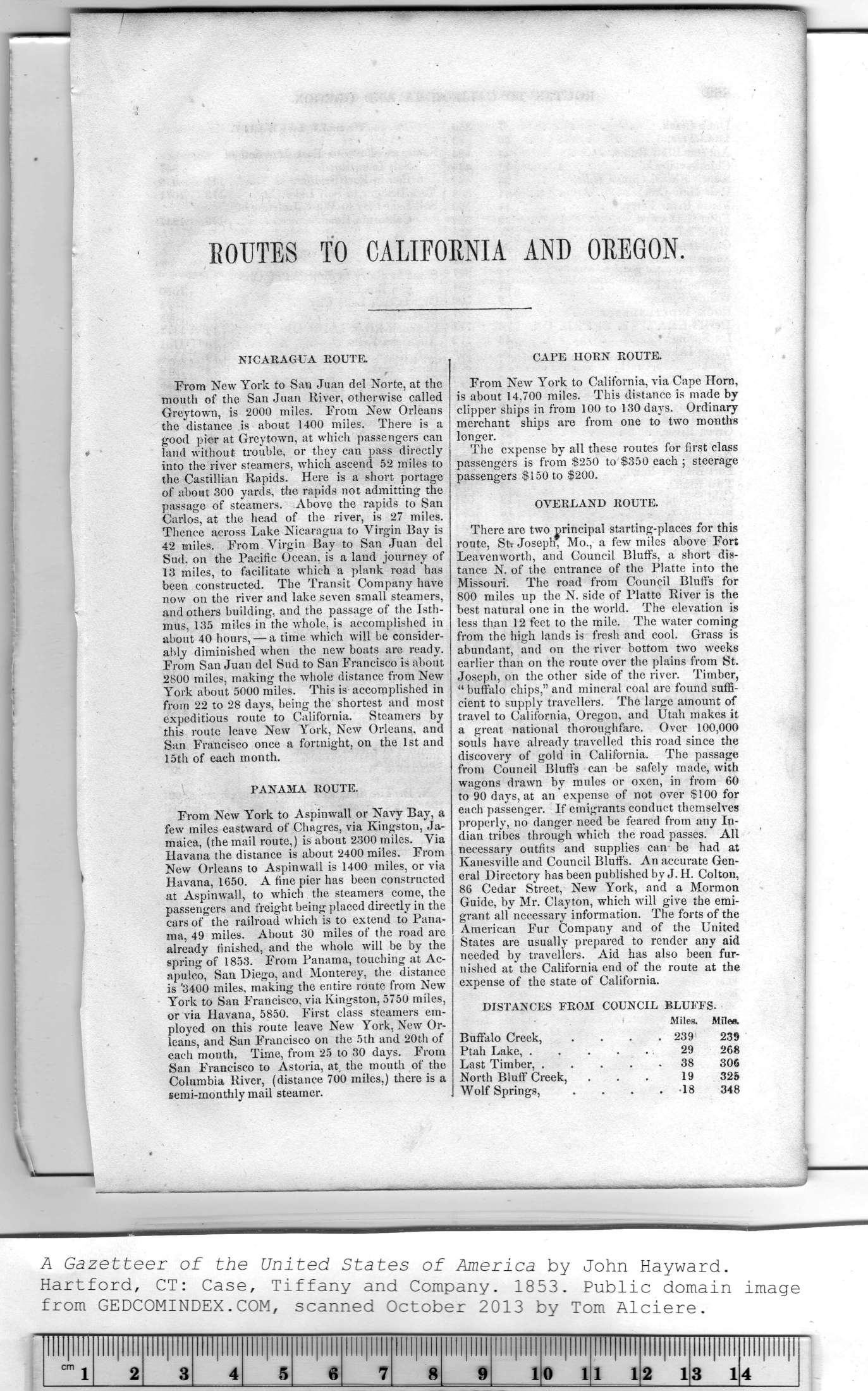|
NICARAGUA ROUTE.
ROUTES TO CALIFORNIA AND OREGON.
From New York to San Juan del Norte, at the
mouth of the San Juan River, otherwise called
Greytown, is 2000 miles. From New Orleans
the distance is about 1400 miles. There is a
good pier at Grey town, at which passengers can
land without trouble, or they can pass directly
into the river steamers, which ascend 52 miles to
the Castillian Rapids. Here is a short portage
of about 300 yards, the rapids not admitting the
passage of steamers. Above the rapids to San
Carlos, at the head of the river, is 27 miles.
Thence across Lake Nicaragua to Virgin Bay is
42 miles. From Virgin Bay to San Juan del
Sud. on the Pacific Ocean, is a land journey of
13 miles, to facilitate which a plank road has
been constructed. The Transit Company have
now on the river and lake seven small steamers,
and others building, and the passage of the Isth-
mus, 135 miles in the whole, is accomplished in
about 40 hours, — a time which will be consider-
ably diminished when the new boats are ready.
From San Juan del Sud to San Francisco is about
2800 miles, making the whole distance from New
York about 5000 miles. This is accomplished in
from 22 to 28 days, being the shortest and most
expeditious route to California. Steamers by
this route leave New York, New Orleans, and
San Francisco once a fortnight, on the 1st and
15th of each month.
PANAMA ROUTE.
From New York to Aspinwall or Navy Bay, a
few miles eastward of Chagres, via Kingston, Ja-
maica, (the mail route,) is about 2300 miles. Via
Havana the distance is about 2400 miles. From
New Orleans to Aspinwall is 1400 miles, or via
Havana, 1650. A fine pier has been constructed
at Aspinwall, to which the steamers come, the
passengers and freight being placed directly in the
cars of the railroad which is to extend to Pana-
ma, 49 miles. About 30 miles of the road are
already finished, and the whole will be by the
spring'of 1853. From Panama, touching at Ac-
apulco, San Diego, and Monterey, the distance
is '3400 miles, making the entire route from New
York to San Francisco, via Kingston, 5750 miles,
or via Havana, 5850. First class steamers em-
ployed on this route leave New York, New Or-
leans, and San Francisco on the 5th and 20th of
each month. Time, from 25 to 30 days. From
San Francisco to Astoria, at. the mouth of the
Columbia River, (distance 700 miles,) there is a
semi-monthly mail steamer.
|
CAPE HORN ROUTE.
From New York to California, via Cape Horn,
is about 14,700 miles. This distance is made by
clipper ships in from 100 to 130 days. Ordinary
merchant ships are from one to two months
longer.
The expense by all these routes for first class
passengers is from $250 to $350 each ; steerage
passengers $150 to $200.
OVERLAND ROUTE.
There are two principal starting-places for this
route, St* Joseph, Mo., a few miles above Fort
Leavenworth, and Council Bluffs, a short dis-
tance N. of the entrance of the Platte into the
Missouri. The road from Council Bluffs for
800 miles up the N. side of Platte River is the
best natural one in the world. The elevation is
less than 12 feet to the mile. The water coming
from the high lands is fresh and cool. Grass is
abundant, and on the river bottom two weeks
earlier than on the route over the plains from St.
Joseph, on the other side of the river. Timber,
“ buffalo chips,'' and mineral coal are found suffi-
cient to supply travellers. The large amount of
travel to California, Oregon, and Utah makes it
a great national thoroughfare. Over 100,000
souls have already travelled this road since the
discovery of gold in California. The passage
from Council Bluffs can be safely made, with
wagons drawn by mules or oxen, in from 60
to 90 days, at an expense of not over $100 for
each passenger. If emigrants conduct themselves
properly, no danger need be feared from any In-
dian tribes through which the road passes. All
necessary outfits and supplies can be had at
Kanesville and Council Bluffs. An accurate Gen-
eral Directory has been published by J.H. Colton,
86 Cedar Street, New York, and a Mormon
Guide, by Mr. Clayton, which will give the emi-
grant all necessary information. The forts of the
American Fur Company and of the United
States are usually prepared to render any aid
needed by travellers. Aid has also been fur-
nished at the California end of the route at the
expense of the state of California.
DISTANCES FROM COUNCIL BLUFFS.
Miles. Miles.
Buffalo Creek, .... 239 239
Ptah Lake,...... 29 268
Last Timber,..... 38 306
North Bluff Creek, ... 19 325
Wolf Springs, . . . 18 348 |

